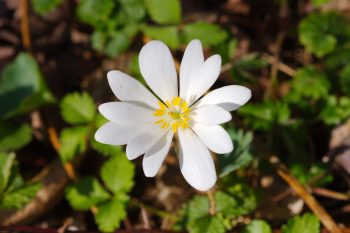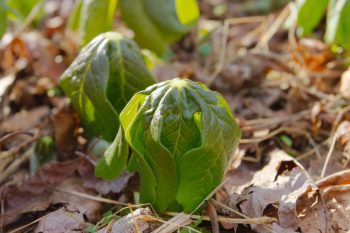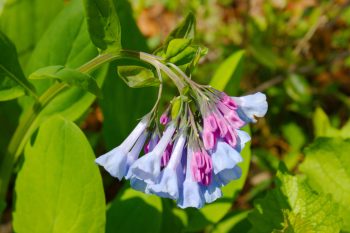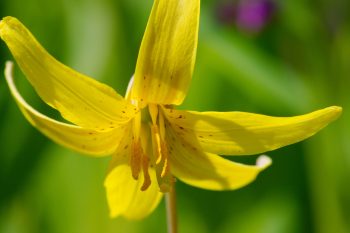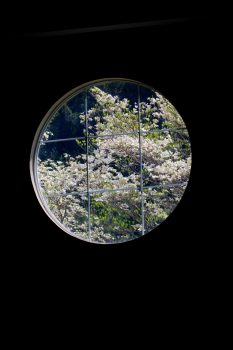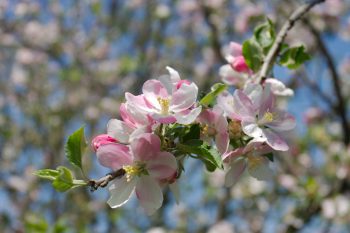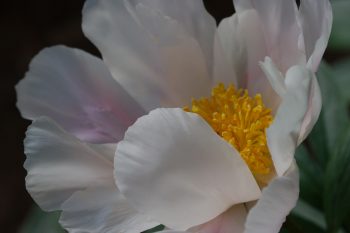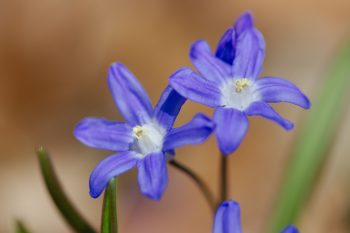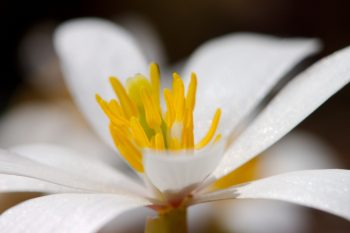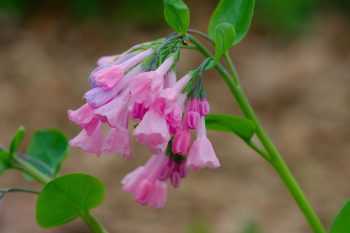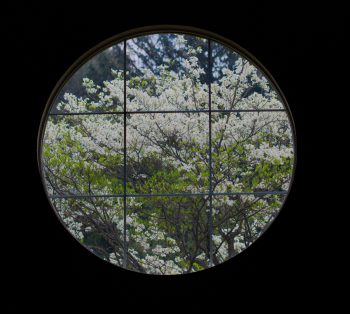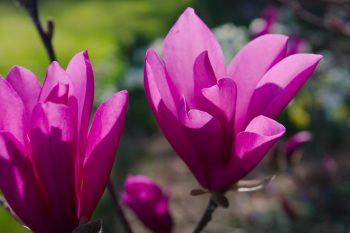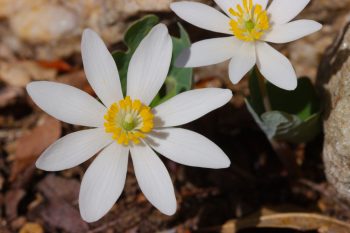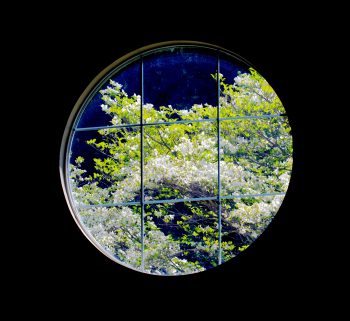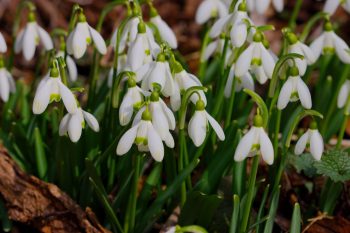We went for a walk near Rock Creek today and enjoyed the spring flowers. The spring beauties (Claytonia virginica) which are in great profusion. We also saw a few bloodroot (Sanguinaria canadensis) as seen here. The flower petals are the purest white with bright yellow stamens. Although they don’t last long, they are quite lovely for the little time they are blooming each spring. The roots have a red sap, which is where they get both their common name and their genus name. The leaves are palmate and deeply-scalloped and attractive in their own right.
Tagged With: Spring
Sanguinaria canadensis (Bloodroot)
Podophyllum peltatum (Mayapple)
We walked in Meadowside Nature Center this afternoon and saw more bloodroot (Sanguinaria canadensis) as seen in yesterday’s photo. We also saw quite a few mayapples (Podophyllum peltatum) coming up. They come out of the ground as cones and then the leaves spread like an opening umbrella. Apparently plants with a single leaf will not flower but those with two will produce a flower stem from the leaf axil (where the two leaf stems branch). While the leaves and roots are poisonous, the fruit, when ripe, can be made into preserves and jellies. I never have, though.
Mertensia virginica (Virginia Bluebells)
Cathy and I went out to Seneca Creek to see the bluebells today. I think they were a few days from their peak but it was still pretty amazing. We walked quite a while and it was a wonderfully beautiful day. We also saw a pair of bald eagles flying overhead and a few common merganser on the creek. One of the cool things about bluebells is the way their color changes from the pink of the buds to the pale blue of the open flowers. The crisp, clear green of their leaves really sets off both colors.
Erythronium americanum (Trout Lily)
On our bluebell walk, we also saw a few trout lilies (Erythronium americanum). They are easy to miss but once you start seeing them, you see them everywhere. The leaves are a sort of mottled green and it’s common to find large patches of them. The flowers are, as you can see here, bright yellow. However, they look downward and the backs of the petals are not so bright, which camouflage them a bit. To get good pictures of them you have to be willing to get down on the ground, which has never been a problem for me.
Dogwood Porthole
I happened to have my camera with me at church this morning and I thought the view through the circular window at the front of the sanctuary was really nice today. We normally sit on the left side of the sanctuary but we were late getting to church and attendance was up a bit so we had to go over to the right side to find seats. I was happy that we did because the view was so nice. There are dogwoods on the hillside outside the church, below the upper parking lot. These dogwoods are in bloom and the sun was on them. I purposefully exposed this for the light levels outside, so the nearly white interior walls show up as very dark here. The small amount of green in amongst the white flowers sets them off very nicely. The beautiful weather encouraged us to go outdoors for a while after church, as well, so the next post is from the same day.
Apple Blossoms
As mentioned in my preview post, we wanted to be outdoors today because it was so nice. We went to the Agricultural History Farm Park and after going through the woodland garden and the Master Garder’s Demonstration Garden, we walked around one of the fields adjacent to the central part of the farm. Between two fields there is a line of a dozen or so apple trees and they were in bloom, which was a really nice bonus. I don’t know how much car these trees get but it appears to be the right amount, at least in terms of their flowering. They were absolutely lovely and the bees and other pollinators were a buzz.
Peony
Cathy and I went up to Seneca Creek State Park this evening to see the Schwartz Peony Garden. It’s perhaps not quite at peak as of today but there were plenty of blooms. There’s a bit of variety in peony flowers and lately I’ve been drawn to the simpler, single flowers, particularly the pale colors. Of course I also like some of the extremely dark and vibrant colors, so it’s not just one or the other. This one, especially in the light we saw it, really caught my eye. The petals look to me as though they were expertly fashioned out of porcelain. It’s just absolutely lovely. Lovely and fleeting.
Chionodoxa Species (Glory Of The Snow)
We went to the Agricultural History Farm Park briefly today. There are bulbs coming up and some Lenten rose in bloom. The photo I’m posting is of a spring ephemeral commonly called Glory of the Snow. The genus name, Chionodoxa, comes from the Greek words chion meaning snow and doxa meaning glory. It’s definitely one of my favorites and I have a fair number of these around the garden at home, including C. forbesii and C. luciliae (which I think this probably is, but I’m not sure).
Sanguinaria canadensis (Bloodroot)
Cathy and I were out in Poolesville today, to drop something off for someone. After that we decided to see if the bluebells have started blooming along Seneca Creek. It is definitely a bit early for the full show, but there was enough to see that we were glad we went. In addition to bluebells, which I’d say were somewhere around 5% open, there were trout lilies (Erythronium americanum), spring beauties (Claytonia virginica), and possibly my favorite spring ephemeral, bloodroot (Sanguinaria canadensis). They bloom very briefly and the flowers are very delicate, so seeing them at their peak is a real treat. Outside their short blooming period they are easily identified by their deeply-scalloped, palmate leaves, but you have to keep your eyes open, because they aren’t very flashy. The flowers are pure white, as you can see here, with beautiful, yellow stamens.
Mertensia virginica (Virginia ‘Pink’ Bells)
Cathy, Dorothy, and I went out to enjoy the bluebells (Mertensia virginica) today. They were pretty much at their peak and it was really lovely. Although they are called bluebells and that’s the predominate color, the buds generally start out being pink or purple and then the flowers turn blue as they open. We found a handful of them, however, that never made the switch, so we dubbed these Virginia ‘Pink’ Bells. There were also trout lilies (Erythronium americanum) and many, many spring beauties (Claytonia virginica), as well as yellow ‘violets’ (Viola pubescens).
Dogwood Portal
I know I posted a similar picture to this last year, on Sunday, April 24, 2022, titled Dogwood Porthole. I entered this year’s title before looking that up to see what I used and was happy that I came up with something slightly different, even if it’s pretty close to the same. At the front of the church is this circular window and on the hill outside it a flowering dogwood (Cornus florida). This year’s photo is about a week ahead of last year’s and that seems about right for the weather we’ve been having. Everything is slightly earlier, although probably not outside the normal range of dates. Last year we had a fairly hard, killing frost in late April but I think we’re probably in the clear this year. I hope so, anyway.
Saucer Magnolia
We were at Tsai-Hong’s house this afternoon and enjoyed some blooms in her garden. She has a lot of daffodils, which are wonderful, and the berries on her winterberry (Ilex verticillata) are wonderful. Nevertheless, the star of the show right now is the saucer magnolia. There are some great varieties of magnolia in the Little Girl series of hybrids developed at the National Arboretum in the mid-1950s from crosses between M. liliiflora and M. stellata. I don’t know if this is one of those or if it has M. denudata in it’s genetics, which is possible. Regardless, it’s lovely.
Sanguinaria canadensis (Bloodroot)
We stoped at the Agriculteral History Farm Park today and especially enjoyed their shade garden. The bloodroot (Sanguinaria canadensis) was in bloom, along with other early spring ephemerals. The Master Gardener’s demonstration garden has only just started to come alive so there wasn’t much to see there, except a large frog on the stones by the little pool.
Wa walked over to see the chickens and I stipped a few times to get pictures of a phoebe (Sayornis phoebe) and another bird I’m not sure about. It was a lovely day and, as usual, we enjoyed being outdoors.
Erythronium americanum (Trout Lily)
After the sunrise and morning worship service, we stopped at home and then took brunch to Cathy’s mom. By ‘we’ I mean Cathy and Dorothy. Dorothy came down for the weekend and we were glad to have her here. Brunch was relatively simple, with quiche Lorraine, fruit salad, Kings Hawaiian rolls, orange juice, and sparkling cider. We also brought a lamb cake that Cathy made yesterday and Dorothy decorated this morning.
From there we went to Berryville Road where it touches Seneca Creek. We walked upstream along the creek and enjoyed the Virginia bluebells (Mertensia virginica) and yellow trout-lilies (Erythronium americanum). It was perhaps a week or two before the real peak but it was still pretty amazing.
Dogwood Blossoms
This is the third year I’ve taken basically this same picture. This circular window is in the front of our church and for a week or two each year the dogwoods on the hill outside give us a show. They bloomed earlier last year and my picture was from April 16. In 2022 it was on April 24. So although the blooms this year seem earlier than previous years, the dogwoods, at least, are not. It reminded me that last year (on May 7) we went to the National Arboretum and really enjoyed their dogwood collection. I don’t know if we’ll be able to make it there in the next week or two, but that would be nice.
Snow Drops (Galanthus nivalis)
Cathy and I took a walk at lunch time today, going about half way around the block that our office is on. There’s a cut through to the parking lot of my building from the back, which is how we got back. We walked through some of the empty lot next to my building but didn’t see much in the way of bird life. That building lot has been empty and waiting to be built on since before Dorothy was born (and before I worked there), so, a long time. In the current market, I don’t see that changing any time soon. On a lighter note, the snow drops (Galanthus nivalis) are blooming.

